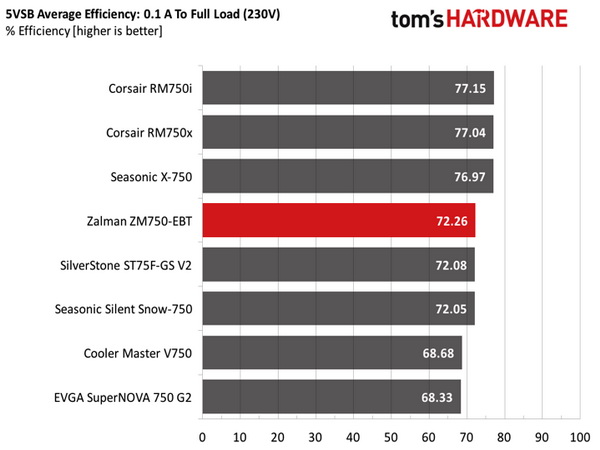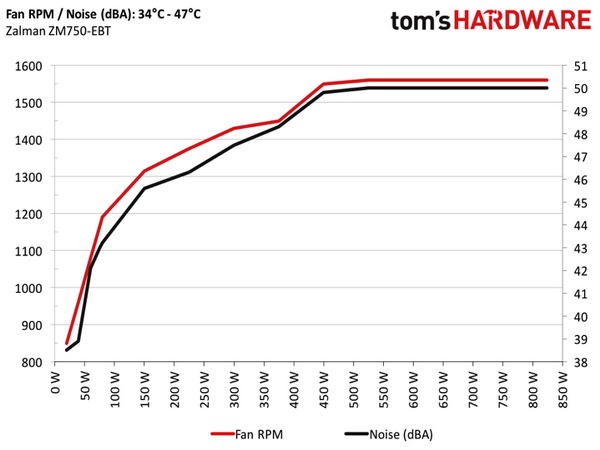Zalman ZM750-EBT PSU Review
Zalman's new EBT line consists of four PSUs ranging from 650W to 1kW capacity. Today, we're testing the ZM750-EBT, which, thanks to a low price, achieves a good value score. But how does it fare in terms of absolute performance?
Why you can trust Tom's Hardware
Efficiency, Temperature And Noise
Efficiency
Our efficiency testing procedure is detailed here.
Using the results from the previous page, we plotted a chart showing the ZM750-EBT's efficiency at low loads, and loads from 10 to 110 percent of the PSU's maximum-rated capacity.




Efficiency trails the competition in this category, and Zalman falls to last place in the light and normal load graphs. Given the modern design of this platform, we expected much higher performance.
Efficiency At Low Loads
In the following tests, we measure the efficiency of Zalman's ZM750-EBT at loads significantly lower than 10 percent of its maximum capacity (the lowest load the 80 PLUS standard measures). The loads we dialed were 20, 40, 60 and 80W. This is important for representing when a PC is idle, with power-saving features turned on.
| Test # | 12V | 5V | 3.3V | 5VSB | DC/AC (Watts) | Efficiency | Fan Speed (RPM) | Fan Noise (dB[A]) | PF/AC Volts |
|---|---|---|---|---|---|---|---|---|---|
| 1 | 1.188A | 0.480A | 0.475A | 0.191A | 19.63 | 64.28% | 850 | 38.5 dB(A) | 0.922 |
| 12.276V | 5.114V | 3.365V | 5.172V | 30.54 | 115.0V | ||||
| 2 | 2.405A | 0.968A | 0.980A | 0.384A | 39.74 | 76.34% | 960 | 38.9 dB(A) | 0.968 |
| 12.275V | 5.109V | 3.360V | 5.167V | 52.06 | 115.0V | ||||
| 3 | 3.618A | 1.459A | 1.488A | 5.161A | 59.84 | 80.78% | 1080 | 42.1 dB(A) | 0.980 |
| 12.272V | 5.105V | 3.356V | 5.161V | 74.08 | 115.0V | ||||
| 4 | 4.828A | 1.962A | 1.968A | 0.775A | 79.82 | 83.02% | 1190 | 43.2 dB(A) | 0.986 |
| 12.267V | 5.100V | 3.351V | 5.155V | 96.15 | 115.0V |
At light loads, Zalman's offering falls significantly behind the other Gold-rated 750W PSUs. Even SilverStone's ST75F-GS V2, which uses exactly the same platform with a few different components, easily beats the ZM750-EBT.
5VSB Efficiency
The ATX specification states that 5VSB standby supply efficiency should be as high as possible, recommending 50 percent or higher efficiency with 100mA of load, 60 percent or higher with 250mA of load and 70 percent or higher with 1A or more of load.
We will take four measurements: one each at 100, 250 and 1000mA, and one with the full load the 5VSB rail can handle.
Get Tom's Hardware's best news and in-depth reviews, straight to your inbox.
| Test # | 5VSB | DC/AC (Watts) | Efficiency | PF/AC Volts |
|---|---|---|---|---|
| 1 | 0.102A | 0.53 | 72.60% | 0.098 |
| 5.178V | 0.73 | 115.1V | ||
| 2 | 0.252A | 1.30 | 75.58% | 0.191 |
| 5.176V | 1.72 | 115.1V | ||
| 3 | 1.002A | 5.18 | 79.33% | 0.319 |
| 5.166V | 6.53 | 115.1V | ||
| 4 | 3.002A | 15.39 | 76.57% | 0.380 |
| 5.128V | 20.10 | 115.1V |


The 5VSB rail achieves close to 80 percent efficiency in the third test. However, under full load, its efficiency drops significantly. This is a clear sign that 3A on this rail are close to its limit. Most likely, this is why ripple suppression is so lousy at higher loads. Zalman should probably keep the max current output on this rail at 2.5A to offer better performance.
Power Consumption In Idle And Standby
| Mode | 12V | 5V | 3.3V | 5VSB | Watts | PF/AC Volts |
|---|---|---|---|---|---|---|
| Idle | 12.265V | 5.120V | 3.372V | 5.178V | 11.18 | 0.702 |
| 115.1V | ||||||
| Standby | 0.08 | 0.012 | ||||
| 115.1V |


In the table above, you'll find the power consumption and voltage values of all rails (except -12V) when the PSU is idle (powered on, but without any load on its rails), and the power consumption when the PSU is in standby mode (without any load, at 5VSB).
Vampire power is very low, especially with 115V input.
Fan RPM, Delta Temperature And Output Noise
Our mixed noise testing is described in detail here.
The first chart below illustrates the cooling fan's speed in RPM, and the delta between input and output temperature. The results were obtained at 34 °C (93.2 °F) to 47 °C (116.6 °F) ambient temperature.
The next chart shows the cooling fan's speed (in RPM) and output noise. We measured acoustics from one meter away, inside a small, custom-made anechoic chamber with internals completely covered in sound-proofing material (be quiet! Noise Absorber kit). Background noise inside the chamber was below 18 dB(A) during testing, and the results were obtained with the PSU operating at 34 °C (93.2 °F) to 47 °C (116.6 °F) ambient temperature.


The following graph illustrates the fan's output noise over the entire operating range of the PSU. The same conditions of the above graph apply to our measurements, though the ambient temperature was between at 28 °C (82.4 °F) to 30 °C (86 °F).
At normal conditions and up to 400W load the PSU is quiet enough, though not silent. Under higher loads, however, its fan quickly speeds up. Naturally, output noise increases as well. At close to 600W, the fan's noise becomes annoying. Look for another PSU if you're out to build a quiet PC.
Current page: Efficiency, Temperature And Noise
Prev Page Load Regulation, Hold-Up Time And Inrush Current Next Page Cross-Load Tests And Infrared Images
Aris Mpitziopoulos is a contributing editor at Tom's Hardware, covering PSUs.
-
Onus Although the article does mention safety, a very valid point, it still managed to imply that a single-rail PSU was "better" due to the complexity of managing rail assignments so as to not trip OCP protections. I've have not seen a multi-rail PSU actually get dinged for this in a review for maybe 8-10 years; it seems that everyone does OCP "right," so this is no longer an issue, ever. That being the case, the greater safety of a multi-rail design is superior.Reply
I'll need to make at least another pass through this article, but failing on +5V ripple under heavy load probably makes this a solid tier-3 unit; I'm not going to run screaming if I see one, but I wouldn't buy it either. -
JQB45 Tier-3 might be generous. There were a lot of cons. What good is a 7 year warranty if the PSU takes something else out in addition to the PSU.Reply
CONS: Ripple • Noisy under stress • Hold-up time • Inrush current • Sleeve-bearing fan • Single EPS connector • Inaccurate PWR_OK signal
Also it must also be strongly pointed out that this unit does not meet ATX specifications. -
Onus True, but the tier-3 units are the ones considered solid for lighter loads. Those cons are why I certainly would not buy one for a gaming or rendering rig, but for the typical PC that may not need even half this power, I wouldn't worry about it.Reply -
Sakkura The fact that it's not just barely breaking the ATX spec at 100% load, but already starts to go out of spec at 80% and then has two rails well out of spec at 100%, is what makes this a tier 4 unit, and a clear "do not buy" regardless of price.Reply -
yyk71200 One would expect that a gold rated powersupply would be at least a solid unit and a safe buy. Guess not. Shouldn't buy one simply based on advertised efficiency rating.Reply -
Onus That's definitely true. Coolermaster taught that lesson quite well.Reply
Hmmm, this one does seem a little worse than I thought at first. Any chance this particular unit had a problem? I'd think ripple could be fixed with a minor capacitor improvement, without adding too much to the price. Hopefully Zalman is paying attention. -
JQB45 Reply17328110 said:That's definitely true. Coolermaster taught that lesson quite well.
Hmmm, this one does seem a little worse than I thought at first. Any chance this particular unit had a problem? I'd think ripple could be fixed with a minor capacitor improvement, without adding too much to the price. Hopefully Zalman is paying attention.
agreed -
COLGeek It is interesting to see Zalman developing this line of PSUs. Hopefully, they will be better than previous generations. Had a couple Zalman PSUs a few years ago, when I used to use Zalman heatsinks.Reply
One died days after the warranty expired and the other about a month after. I'll give Zalman credit, they made right by me by exchanging both, but it was a painful process.
While I would not recommend these current products, I can at least "tolerate" them in budget builds. -
turkey3_scratch I would think anything out of spec should be Tier 4. Ripple is trash. 3.3V rail was on the brink of being out of spec. 12V was also quite terrible at 90mv.Reply
Anyway, I like your power supply reviews, Toms. You go more in-depth than any review site for power supplies (Hardwaresecrets, Johnnyguru). -
Sakkura Reply17328110 said:That's definitely true. Coolermaster taught that lesson quite well.
Hmmm, this one does seem a little worse than I thought at first. Any chance this particular unit had a problem? I'd think ripple could be fixed with a minor capacitor improvement, without adding too much to the price. Hopefully Zalman is paying attention.
Considering the same platform performs decently in the Silverstone unit, there's at least some hope that Zalman can go back, adjust a few things, and get a decent budget unit out of this.
Edit: I went back and looked at the Silverstone review. Ripple suppression was really good up to 90% load, then the 5V and 3.3V rails jumped hugely, especially the 3.3V. They did stay within ATX spec, but just barely. The 5V ripple went from 13.1mV at 90% to 40.5mV at 100%, 3.3V ripple went from 14.1mV at 90% to 49.9mV at 100%. Obviously the 3.3V ripple went out of spec at 110% load, as well as one of the crossloads, but that's a lesser sin.
